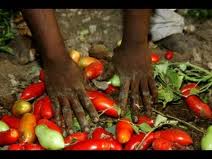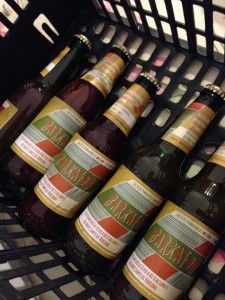 Following my earlier post on the racial geography of the Black Mediterranean, colleagues keep pointing me at North-South connections in agri-food commodity chains, particularly with regard to tomatoes. My colleague Christian Berndt, for example, has written this wonderful comparison between the EU/North Africa and US/Mexico borderlands together with Marc Boeckler (click here for pdf and here for a link to the edited book chapter). They adopt a consciously marginal perspective – a view from the border – to document the heterogeneous associations that literally connect the agricultural fields to the supermarket shelves.
Following my earlier post on the racial geography of the Black Mediterranean, colleagues keep pointing me at North-South connections in agri-food commodity chains, particularly with regard to tomatoes. My colleague Christian Berndt, for example, has written this wonderful comparison between the EU/North Africa and US/Mexico borderlands together with Marc Boeckler (click here for pdf and here for a link to the edited book chapter). They adopt a consciously marginal perspective – a view from the border – to document the heterogeneous associations that literally connect the agricultural fields to the supermarket shelves.
“In tracing the network tomato we posed one central question: How is the tomato held stable as a tomato while it is not only displaced through space but also subject to multiple ways of b/ordering that try to control the double play of framing and overflowing?”
The authors interestingly conclude with a quote form Ulrich Beck: “It is not the dissolution of borders, but rather border negotiation and border work which is at the heart of current globalisation processes.”
Their approach reminded me of the original approach taken for example by Ian Cook et al. (Follow the Papaya). As Cook writes while following his papaya from the field to the plane, to the London supermarket, and to the fruit bowl:
Although the narrative appears linear, it is not, as cross-cutting connections are drawn among and outside its constitutive stages: to colonialism, to the World Trade Organization (WTO), to Western middle-class consumption aesthetics, to the diseases and pests of exotic fruits, to the character of international air cargo transportation, and to developing-world labour control and surveillance. This is an unbounded, dense network of associations. And precisely because it isn’t a simple chain, the commodity itself is no ‘trivial thing’; it is composite, defetishized, decrypted, reflecting all manner of trace effects.
Years ago I remember seeing this Brazilian documentary that followed a tomato from the field -where it grows, is watered, taken care off, and then, as it is further transported, sold and carried home, it ends up in the garbage of one wealthy family in Rio de Janeiro (unfortunately I cannot find the documentary any more, if anyone can give me a hint that would be highly appreciated).
A friend journalist then mentioned this feature on the Dark Side of the Italian Tomato by Mathilde Auvillain and Stefano Liberti.
“Makola market, the main market in Accra – one of the largest in Western Africa – is the commercial heart of the capital (…) Everywhere, wooden stalls seem to be laden down by red tins of tomatoes, skilfully balanced by the sellers in mysterious geometric formations. (…) “Salsa”, “Fiorini”, the brands are Italian pastes (…) even the Chinese product “Gino” displays the Italian tricolour on the tin to attract customers.”
“(…) the government should have limited the quantity of tomato paste coming in from abroad. “If the market had been regulated, the farmers would’ve gotten better prices and would’ve had a market for their produce. But the government did the exact opposite. It swung open the doors of the country to imports of European tomato paste. Now there’s such a wide choice and such an amount of produce that it’s practically impossible to sell locally-grown tomatoes”.
The webdoc concentrates amongst others on the swamping of African markets by European and Chinese tomato paste. What I didn’t know is that many of the African day labourers who end up picking tomatoes in Southern Europe come from tomato growing regions themselves; as a result of commercial dumping, these producers often have no other choice than to re-enter the commodity chain as unfree labourers. Bernard Hazard already mentioned Béguédo in Burkina Faso. The documentary by Mathilde Auvillain and Stefano Liberti furthermore mentions Upper east Region in Ghana. This raises the further question how African seasonal workers are recruited, how their labour force figures in a wider restructuration of agri-commodity chains dominated by big retail businesses, and how informal employment schemes intermingle with formal border regulations.
Finally last week, I became acquainted with an alternative way of organizing local tomato productions during a fair organised by SOS Rosarno. With their help, a group of African producers from Venosa, Basilicata, proposed their product, bottled tomato sauce, which says ‘free from labour exploitation’. Labourers are regularly employed without the intervention of criminal intermediaries, or caporali.




Hi
Great post. Thanks.
That tomato doc you weer looking for is featured on our website too. Jorge Furtado’s (1990) Ilha das Flores. See: http://www.followthethings.com/ilhadasflores.shtml
Is that it!?
Best wishes
Ian
Hi Ian, yes exactly, I saw it years ago but it still strikes me as extremely appealing and relevant. Thanks also for your kind words.